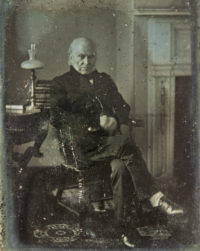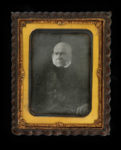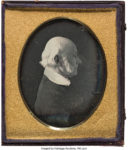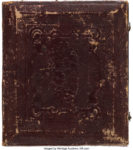 In a long, eventful life filled with accomplishments, John Quincy Adams often gets the credit for the one thing he didn’t do: being the first President of the United States to be photographed. That record goes to William Henry Harrison, poor sod, who had his picture taken around the time of his inauguration in 1841. Thirty-one days later, he was dead of a fever. (Legend has it he delivered his interminably long inaugural address without a coat thereby “catching cold” which developed into pneumonia and killed him. Now we know that the weather cannot infect you with disease — pathogenic microorganisms do that job — but it makes a good story so it has lingered as the dominant account of how the shortest presidential term of office came to such an abrupt end.) Adams was the second resident of the White House to photographed, albeit many years after his first and only term as President. It was in 1842 and only reprints and copies of that image and the Harrison portrait are known to survive today. The originals are lost.
In a long, eventful life filled with accomplishments, John Quincy Adams often gets the credit for the one thing he didn’t do: being the first President of the United States to be photographed. That record goes to William Henry Harrison, poor sod, who had his picture taken around the time of his inauguration in 1841. Thirty-one days later, he was dead of a fever. (Legend has it he delivered his interminably long inaugural address without a coat thereby “catching cold” which developed into pneumonia and killed him. Now we know that the weather cannot infect you with disease — pathogenic microorganisms do that job — but it makes a good story so it has lingered as the dominant account of how the shortest presidential term of office came to such an abrupt end.) Adams was the second resident of the White House to photographed, albeit many years after his first and only term as President. It was in 1842 and only reprints and copies of that image and the Harrison portrait are known to survive today. The originals are lost.
That’s why there was so much excitement earlier this year when the news broke that an original daguerreotype of Adams taken by photographer Philip Haas at his studio in Washington, D.C. in 1843 emerged from the obscurity of attic clutter to the bright lights of Sotheby’s. It was the earliest known surviving original photographic portrait of a US president. Bidding was not surprisingly fierce and there was much rejoicing in the history nerddom when the National Portrait Gallery announced a few days after the auction that they had placed the victorious bid.
 You wouldn’t know from how rare these original plates are, but as it turns out John Quincy Adams was a bit of a camera whore (said in reverent awe, Mr. President’s ghost, not disrespect). Louis Daguerre presented his new technology to the public in 1839, so when Adams sat for his first portrait in 1842, the process was still in its infancy. In March of 1843, he had another portrait taken, his first by Philip Haas. Then he went back Haas’ shop a week later to have the portrait redone because none of the ones from the first session came out right. His diary entries on those dates reveal his fascination with the “camera obscura” device and how it worked.
You wouldn’t know from how rare these original plates are, but as it turns out John Quincy Adams was a bit of a camera whore (said in reverent awe, Mr. President’s ghost, not disrespect). Louis Daguerre presented his new technology to the public in 1839, so when Adams sat for his first portrait in 1842, the process was still in its infancy. In March of 1843, he had another portrait taken, his first by Philip Haas. Then he went back Haas’ shop a week later to have the portrait redone because none of the ones from the first session came out right. His diary entries on those dates reveal his fascination with the “camera obscura” device and how it worked.
Getting his picture taken by top society photographers became a regular thing for John Quincy. In September of 1842, six months before he first visited Philip Haas, he sat for photographer John Plumbe at his Boston gallery, then again at Plumbe’s studio in D.C. three more times all in 1846. The second of these four sessions took place on February 14th, 1846. The former President noted in his diary that he went to “Plumbe’s Daguerreotype office” where they took two shots of him: “a full face and a profile, both quite successful.”
The reference in Adams’ diary was the only evidence of the existence of the “quite successful” profile picture by John Plumbe. If it was published, printed, reproduced or in another way disseminated we don’t know about it.
 How is there a profile image of President John Quincy Adams published right here in this humble blog then, you boldly but fairly query? It’s not a print, reprint or a copy, though. (Okay it’s a digital copy. You know what I mean.) It’s the original plate shot and developed by Plumbe. It just randomly turned up recently at a Paris antiques market, was spotted by someone with a good eye, got conserved, appraised and authenticated by top experts and it’s all over but the spending.
How is there a profile image of President John Quincy Adams published right here in this humble blog then, you boldly but fairly query? It’s not a print, reprint or a copy, though. (Okay it’s a digital copy. You know what I mean.) It’s the original plate shot and developed by Plumbe. It just randomly turned up recently at a Paris antiques market, was spotted by someone with a good eye, got conserved, appraised and authenticated by top experts and it’s all over but the spending.
It’s a quarter plate Daguerreotype in a burgundy-glazed leather case lined with purple silk and velvet. The brass matt is stamped “Plumbe” and cover of the case is embossed with a basket of flowers design that case was one of Plumbe’s signature motifs. The compartment that holds the plate has a paper liner that reads 
 “Manufactured at the Plumbe National Daguerrian Depot, New York.” And the portrait itself is undeniably John Quincy Adams’ mutton-chopped mien in noble profile.
“Manufactured at the Plumbe National Daguerrian Depot, New York.” And the portrait itself is undeniably John Quincy Adams’ mutton-chopped mien in noble profile.
The 1846 Plumbe daguerreotype of John Quincy Adams will be offered at Heritage Auctions’ Americana sale on December 2nd with a pre-sale estimate of $50,000. HA has a strong web component; you can bid early online and the bids are already up to $25,000. Given the results of the last auction where a John Quincy Adams portrait went far and beyond all pre-sale expectations, $50,000 could be surpassed within minutes.